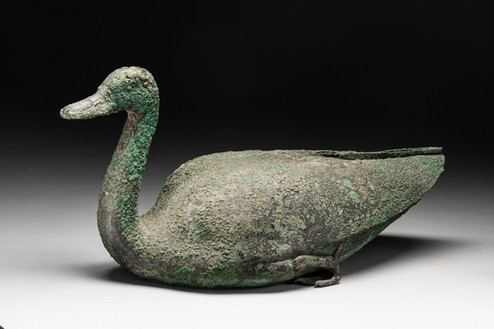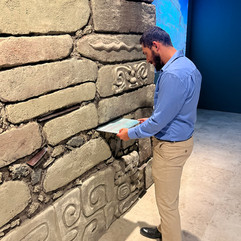Terracotta Warriors Make a Comeback in Santa Ana
- Richard Chang

- Jun 30
- 4 min read
The Bowers Museum exhibition features more than 110 newly discovered treasures from Shaanxi province, China, all making their North American debut.

The world-famous Terracotta Warriors have returned to the Bowers Museum in Santa Ana, but how is this exhibition different than the previous large-scale iterations at the museum in 2008 and 2011?
Well, first, this version features more than 110 newly unearthed treasures from Shaanxi province, all making their North American debut.
Also, 2024 was the 50th anniversary of the discovery of the first terracotta army pit in Xi’an in the 1970s – a find that reshaped global understanding of ancient China.
“World of the Terracotta Warriors: New Archaeological Discoveries in Shaanxi in the 21st Century” is the Bowers’ major, specially ticketed exhibition for 2025. It runs through Oct. 19.
“This is not just about Terracotta Warriors, it’s about the preceding 2,000 years,” said Seán O’Harrow, president and CEO of the Bowers. “It’s the new material that’s been discovered since (the last) Terracotta Warriors (exhibition). In order to see all this other material, you would have had to travel hundreds of miles to get there. So it’s nice to have it all together to tell one cohesive story that goes back a few thousand years.”
“World of the Terracotta Warriors” features sculptures, pottery, jewelry, architectural elements, clay and bronze animal figures and of course, the Terracotta Warriors, some of them dating back to 221-206 BCE (Before Common Era). The exhibition also features multimedia and interactive elements, such as a reproduction of an ancient Shimao wall where visitors can pull out panels and discover pieces of jade (not real) and learn more about the precious gem’s significance in Chinese culture; and kiosks or stations where you can digitally “paint” your own terracotta warrior. Contrary to the indistinct, beige color of the current terracotta warriors, the figures were actually brilliantly painted when they were buried with the first emperor of China, Qin Shi Huang.
According to O’Harrow, each terracotta warrior actually represented a real member of Emperor Qin’s army – that’s why their features and costumes are so specific.
There’s also an immersive video that reproduces the burial of Emperor Qin as it may have looked just after his death in 210 BCE, and illustrates how some of the warriors were made and placed. At the time of his burial, Emperor Qin was surrounded by a pool of mercury, making it deadly to approach his tomb. Some of that is represented in the video.
Artifacts from the Terracotta Warriors exhibit on display at Bowers Museum. PHOTO 1: A ritual wine vessel from the late Shang to early Western Zhou dynasty, excavated from Shigushan Site, Baoji in 2013. PHOTO 2: An armored warrior figure, from the Qin dynasty (221-206 BCE) excavated from pit number one, Qin Shi Huang Mausoleum Complex, Xi'an in 1883. PHOTO 3: A gold belt ornament with hollow dragon pattern. PHOTO 4: A high-level armored military official figure from the Qin dynasty excavated from pit number one, Qin Shi Huang Mausoleum Complex, Xi'an in 1979. PHOTO 5: A goose sculpture from the Qin dynasty, excavated from pit K0007 at the Qin Shi Huang Mausoleum Complex, Xi'an in 2023. PHOTO 6: A kneeling archer figure from the Qin dynasty, excavated from pit number two, Qin Shi Huang Mausoleum Complex, Xi'an in 1983. Images courtesy of Bowers Museum
Other highlights of the exhibit include the oldest carving of a horse in the history of China, according to O’Harrow, dozens of illustrated historical panels, and a pair of bronze horse-drawn chariots (221-206 BCE) excavated from a pit 22 yards west from Qin Shi Huang’s Mausoleum. However, before you get too excited about the chariots, a small parenthetical note says that they are actually replicas, which O’Harrow confirmed. (He said the replicas were made in the late 20th century.)
“World of the Terracotta Warriors” was jointly organized by the Shaanxi Provincial Cultural Heritage Administration, the Shaanxi Cultural Heritage Promotion Center, Emperor Qin Shi Huang’s Mausoleum Site Museum and the Bowers.
The exhibition was curated for the Bowers by Tianlong Jiao, the Bowers’ chief curator since December 2023.
PHOTO 1: Visitors look at the Terracotta Warriors in the Bowers Museum's latest exhibition. PHOTO 2: A visitor inspects ancient vessels. PHOTO 3: Visitors check out two bronze, horse-drawn chariots, which are actually replicas. PHOTO 4: A visitor pulls out a panel from a reproduction of an ancient Shimao wall to read about jade and its history in Chinese culture. Images courtesy of Bowers Museum
Mark Bustamonte, who was recently promoted to director exhibitions (he previously served as director of special exhibitions), said the story of the Terracotta Warriors, their creation, burial and discovery, is astounding the more you learn about it.
“The Terracotta Warriors have not left China since 2019,” he said. “You can’t see these anywhere else in the United States. That alone makes it really exceptional.”
But why should the average, lay person care about a bunch of old, clay statues and Chinese artifacts in a Santa Ana cultural museum?
China “is one of the most important countries on earth. It’s a huge geopolitical power,” Bustamonte said. “Studying early China tells us a lot about what it is today. And then the artistry you see in the exhibition. Every single one of these pieces – there’s some decorative element there.”
“World of the Terracotta Warriors” will travel to the Houston Museum of Natural Science after it closes at the Bowers in October.
‘World of the Terracotta Warriors’
Where: Bowers Museum, 2002 N. Main St., Santa Ana
When: Through Oct. 19; hours are 10 a.m.-4 p.m. Tuesdays through Sundays
Cost: $29 for adults, with discounts for seniors, students and members
Contact: 714-567-3600 or bowers.org

























.png)







.png)

.png)
